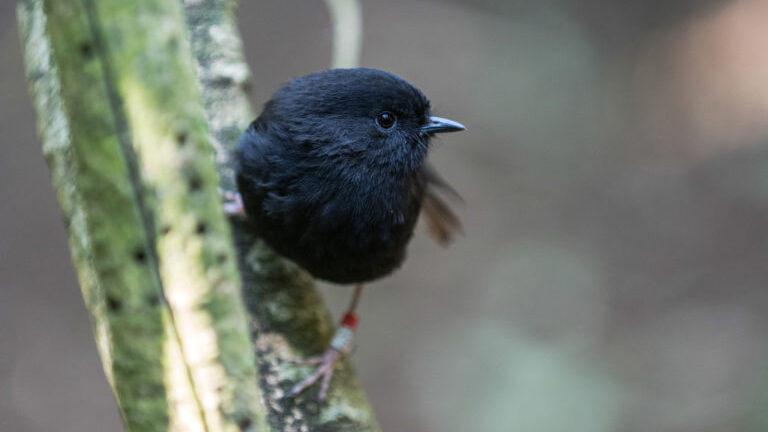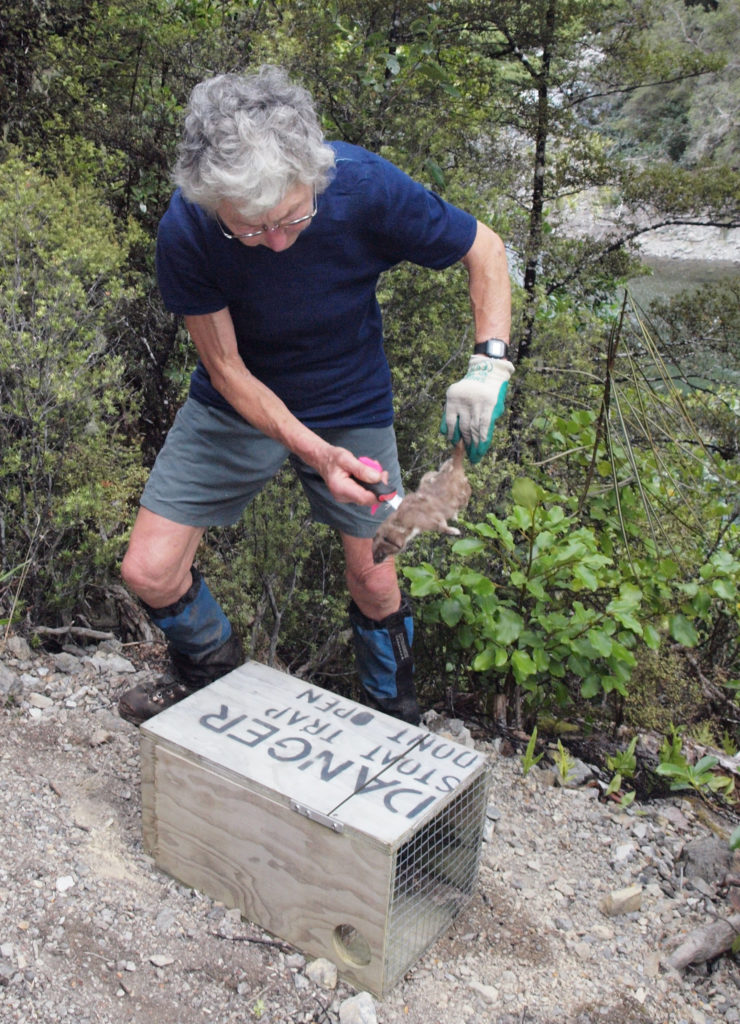Conservation genetics has implications for all sorts of conservation measures. Whether it be choosing the source birds for a translocation to a new sanctuary to ensure sufficient genetic diversity, ‘forensic’ type investigations to identify the source of a newly arrived predator on an island (where a swimming stoat has come from, for example), or research into potential genetic pest management tools. It’s not just the wider public who is learning about the possibilities.

Practitioners on the conservation frontlines are faced with the challenge of understanding and keeping up with developments as well, if they are to incorporate genetics into their work in a practical way.
So how well do conservation practitioners understand conservation genetics and what do they feel about it all? Conservation geneticists from the University of Otago recently surveyed their colleagues on the frontline at the Department of Conservation to determine how well conservation genetics was understood at DOC, what the attitudes to it were and what might be needed to bridge information gaps and/or barriers to implementation. The results have just been published in Global Ecology and Conservation.
The study
“The DOC is NZ’s main government conservation body, employing 1637 staff, with ∼400 directly involved in biodiversity management. Survey data were gathered using internal email lists targeting the majority of these 400 staff. We collected complete survey responses from 148 DOC employees, representing ∼36% of DOC staff engaged in biodiversity management.”
“Respondents spanned a broad range of age groups, educational backgrounds, and tenures at DOC. Respondents’ responsibilities ranged from biodiversity rangers to scientific advisors and heads of species’ recovery groups, covering both plant and animal interests.”
Why it matters
As conservation genetics techniques advance, it is becoming increasingly important to ‘bridge the conservation genetics gap’ in the interests of making the best possible decisions for our indigenous wildlife.
“Despite its recognised importance for species’ persistence, integrating genetics into conservation
management has proved problematic, creating a ‘‘conservation genetics gap’’, which could widen with the advent of advanced genomic techniques. Bridging this gap requires a clear understanding of the barriers to use of genetics by conservation practitioners…”

“Although practitioners were largely receptive to using genetics for conservation management, access to expertise and funding remains a barrier to use. Practitioners would like to collaborate with geneticists at universities or other institutes, but do not necessarily know who to talk to or fully understand how genetics might benefit them.”
Jargon doesn’t help
“The increasing use of genomics has the potential to exacerbate the conservation genetics gap, as complex concepts within this field are couched in jargon that can cause confusion. Now, more than ever, it is important to ascertain the forces behind the conservation genetics gap, before rapidly evolving genomic technologies make it too wide to cross. Here, we identify drivers of the conservation genetics gap by collecting data directly from conservation practitioners, using New Zealand’s main government conservation agency as a case study.”
Situation to date
“Genetic issues associated with small and isolated populations had historically been ignored by NZ’s conservation practitioners because NZ species were considered less vulnerable to threats such as inbreeding, and because there were more pressing threats (eg. introduced predators) to contend with. Genetic factors are now included in recovery plans for several NZ species but are not fully integrated into the threat classification system.”
DOC staff view of conservation genetics?
“Conservation genetics was positively perceived by most respondents. Respondents believed genetic management was important to species persistence. Of those who gave more detailed answers, some thought genetic management could improve species’ resilience to disease events and environmental changes (52%), while others felt it could help avoid inbreeding (20%). However, 22% were cautious, stating that the importance of genetic diversity to persistence varied among taxa, as some species seemed to remain viable despite low genetic diversity.”
Impact on DOC practice
“Respondents also felt that genetics has had a positive impact on conservation practice. Thirty-two percent of those who expanded on this answer felt genetics led to more informed conservation decisions, 21% that genetics promotes better understanding of taxonomy and natural history, and 15% that genetics mitigates inbreeding and improves captive management. Nearly all respondents would like to see genetics better integrated into conservation management.”
Barriers to integration
“…respondents were ambivalent or negative about whether they had sufficient knowledge of conservation genetics to facilitate better integration; most desired more information on conservation genetics tools and management. Most respondents felt that genetics could be useful across the seven common conservation issues presented, but this did not consistently translate into genetics being used to tackle these issues in reality. Many respondents (70%–88%) working in areas where translocations, inbreeding, captive breeding, and taxonomic uncertainties are relevant, stated that they had employed genetic techniques. However, use of genetic techniques was lower for those working on wildlife forensic issues (57%), and negligible (33%–37%) for invasive species control, and disease and parasites.”
“Reasons for not using genetic techniques varied between issues. Major barriers were lack of expertise (28%–50%), particularly for those working on translocations (50%) and taxonomic uncertainties (46%), and a lack of funds (19%–42%). Roughly a third of respondents thought genetics was irrelevant for addressing invasive species, and disease and parasite problems (35% and 29%, respectively), versus 0%–10% across other issues. Open-ended answers revealed that genetics was not considered part of DOC best practice, or a cost-effective solution, and timeframes required to generate genetic data were perceived as too long.”
Available expertise
“Conservation genetics expertise is not felt to be readily available within DOC. Most (70%) respondents stated they did not currently have anyone with genetics expertise or training on their team. There was ambivalence regarding the usefulness of in-house geneticists: 36% stated it would be useful to have specialised help, but 42% preferred to maintain external collaborations (e.g., with universities) and avoid internal bureaucracy.”
Collaboration process
“Many respondents (63%) had collaborated with external geneticists and their experiences were largely positive, featuring clear communication and expectations management, and resulting in clear management recommendations. Respondents who had received management recommendations had implemented them to some extent, although only 13% had followed them to the letter. Where recommendations were not fully implemented, this was mostly (60%) due to a lack of funds. A further 30% stated that by the time the recommendations were received, the situation had changed, rendering the recommendations irrelevant, but only 10% of respondents disregarded recommendations because they disagreed with them.”
Positive perceptions – so why the barriers?
Negative perceptions can no longer be viewed as a barrier to use of conservation genetics in NZ. The perception of genetics as a conservation tool among conservation practitioners in NZ is overwhelmingly positive. There is still a persistent view (∼20 respondents) that genetic diversity is not important for all taxa, likely due to ‘‘successes’’ such as the Chatham Island black robin (Petroica traversi) and little spotted kiwi (Apteryx owenii), both of which are perceived to have recovered from extreme genetic bottlenecks. In reality, both species are negatively affected by inbreeding depression. It has been suggested that the benefits of genetics are not fully understood by
practitioners. In NZ at least, this is only partly true.”
What needs to be done?
“Education is required around the role genetics can play in the control of disease and invasive species, to counter a pervasive opinion that genetics is irrelevant despite numerous publications applying genetics to these issues by NZ scientists. This disconnect may result from the fact that invasive species management in NZ is still largely focused on eradication via trapping and poisoning. Advanced genetic techniques to combat invasive species are still in development and many practitioners may not be aware of them. A key positive point from our data is that practitioners are aware they do not have enough knowledge of genetics to properly integrate it into conservation management and are keen to receive more information. This provides an opportunity for geneticists to better communicate the relevance of their methods for addressing the biodiversity crisis.”
Funding and other issues
“The main barriers to use we identified here were insufficient funding (also identified as a reason for not implementing recommendations) and a perceived lack of genetics expertise. These barriers have resulted in a lack of application of genetics research, even in areas where it is perceived to be highly relevant. It is not clear whether the lack of funding was due to a lack of funding for conservation in general, or because the management actions suggested by geneticists were too expensive to implement. We suggest the former as conservation is chronically under-funded.”
Communication priorities
“The perceived lack of genetics expertise is worrying in a country with an active community of conservation geneticists and could have two non-mutually exclusive causes. External geneticists may not be proactively engaging with DOC practitioners, and/or external geneticists may have a few main points of contact at DOC, but their contact details are not being communicated throughout the department. Clearly, making conservation geneticists and their research more visible and accessible to practitioners should be a priority in NZ.”
The full report is published in Global Ecology and Conservation and is freely available.

